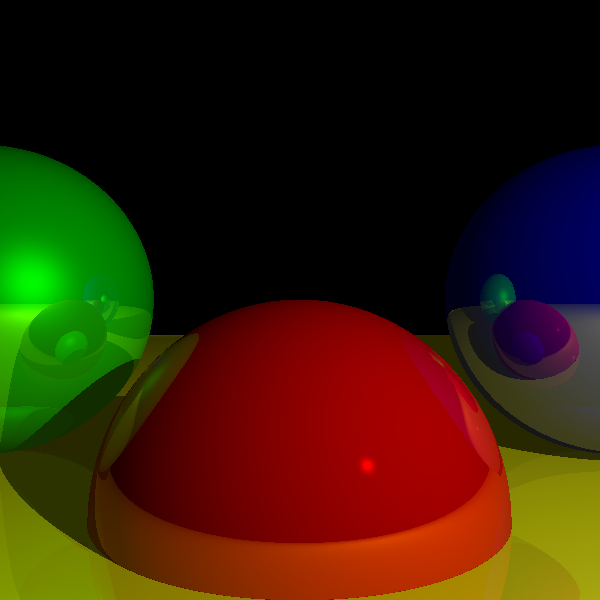Tiny Raytracer
I love raytracers. Their combination of a simple algorithm and stunning results are hard to beat.
I’ve written several raytracers over the years, including the one in Computer Graphics from Scratch, but this time I decided to write the smallest possible one I could write. My current version is 912 bytes of Javascript, and I’m sure it’s still possible to shave off a few more bytes. Note that the size includes a simple scene definition.
Here’s the full source code:
var G=600,S=[G,[0,-G,0],9,9,0,G,2,1,[0,0,3],9,0,0,G,3,1,[-2,1,4],0,9,0,9,4,1,[2,1,4],0,0,9,G,5],a=2,L=[8,[2,2,0]],M=Math,Q=M.sqrt,X=M.max,o=0,C=document.getElementById("c"),Z=C.getContext("2d"),m=Z.getImageData(0,0,G,G),W=m.data,d=(A,B)=>A[0]*B[0]+A[1]*B[1]+A[2]*B[2],A=(A,B,k)=>[A[0]-B[0]*k,A[1]-B[1]*k,A[2]-B[2]*k],I=(O,D,m,M)=>{t=G;for(c=i=0;r=S[i++];i+=6)if(j=A(O,S[i],1),a=2*d(D,D),b=-2*d(j,D),k=Q(b*b-2*a*(d(j,j)-r*r)))for(e=2;e--;k=-k)f=(b-k)/a,m<f&&f<M&&f<t&&(c=i,t=f);return c},T=(O,D,m,r)=>{if(s=I(O,D,m,G)){N=A(P=A(O,D,-t),S[s],1);n=d(N,N);i=a;for(l=0;e=L[l++];)p=d(N,v=A(L[l++],P,1)),i+=e*!I(P,v,1/G,1)*(X(0,p/Q(d(v,v)*n))+X(0,M.pow(d(R=A(v,N,2*p/n),D)/Q(d(R,R)*d(D,D)),S[s+4])));O=S[s+H]*i*2.8;m=S[s+5]/9;return r--?(T(P,A(D,N,2*d(N,D)/n),1/G,r)|0)*m+O*(1-m):O}};C.width=C.height=G;for(y=h=G/2;y-->-h;)for(x=-h;x++<h;){for(H=0;4>++H;)W[o++]=T([0,1,0],[x/G,y/G,1],1,2);W[o++]=G}Z.putImageData(m,0,0);
And here’s the output:

The original, fully commented source code can be found here. Note that the goal here was to make the source code as small as possible, not clarity; so even the original code before minification is a horrible mess. This doesn’t do justice to the elegance and simplicity of proper raytracer code; half of my book Computer Graphics from Scratch builds a raytracer step by step.
Here’s a live demo. It should run in any reasonable browser these days.